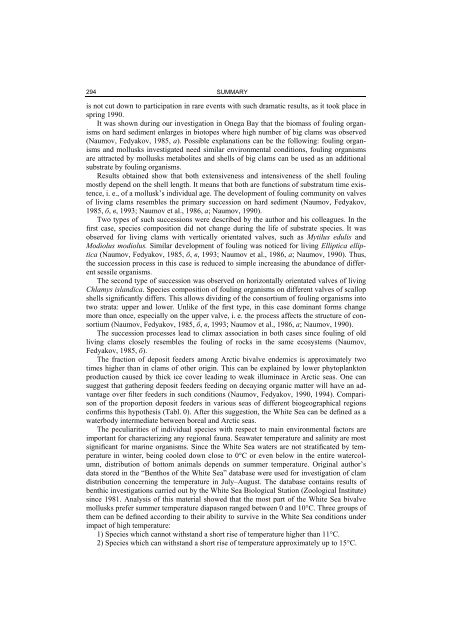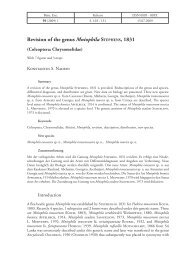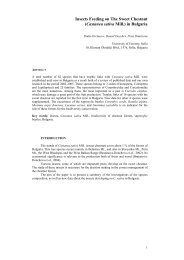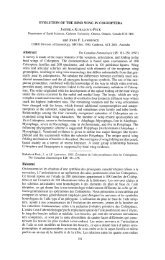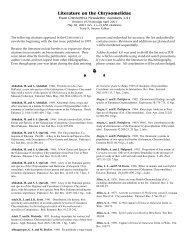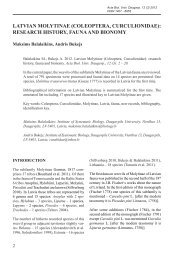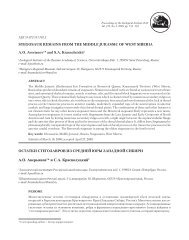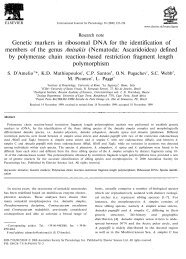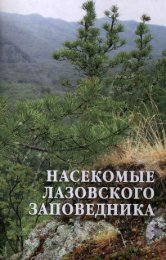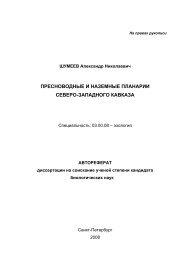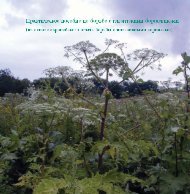SUMMARY 293The study of fauna of any region is closely connected with the investigation of taxonomicposition of species within the taxa under consideration. Traditionally, the verbalshell description is mostly used in bivalve mollusks systematics. In spite of the numerousmodern molecular researches, the conchological features make up the basics of our knowledgein this field up to now. That is why many malacologists try to formalize valve shapein order to make possible mathematical processing of data. Calculation of shell proportionsbecame one of the first steps in this direction. This method primary used in the beginningof the 20-th century (Odhner, 1915; Mossewitsch, 1928; Mesiacev, 1931) seemed verypromising and many authors suggested results of the shell shape analysis as crucial; but forall neither ecological plasticity nor age dynamics of the shell proportions were taken intoaccount. A number of species and infraspecific forms were recognized (Derjugin, Gurjanova,1926; Mossewitsch, 1928; Mesiacev, 1931) unfoundedly as a result. The approachdescribed was very important, no doubt, but it should be notified that regression analysiswidely extends the possibilities of mathematical methods in bivalve mollusks systematics.On one hand, it allows distinguishing closely related species with similar shell proportions,and on the other it proves to be a convenient tool for exploration of an intraspecific variability(Naumov, Fedyakov, 1985, г). Moreover, it allows synonymizing mistakenly describedspecies. Thus, the analysis of relationships between different dimensions of clamshells is very useful as a parallel approach to traditional investigation of their shape, because,in some cases, it becomes more informative and permits direct comparison of differentaged samples. That is why in every case when available material allows, both proportionsof the shell and regression equations are included in species diagnoses placed in thisbook.The fauna inventory being an essential base of any faunistic investigation cannot be theend in itself nowadays. There are numerous important aspects concerning ecosystems functioning:Seasonal and long-term dynamics of species abundance in concrete biotopes is oneof them. Investigation tradition considers such changes to be related with impact of abioticfactors. Meanwhile, the more data is accumulated, the more cases of dynamics that cannotbe explained by direct influence of environmental characteristics we observe.Previous observations of dense settlements of Mytilus edulis (Lukanin et al., 1986, а, б,1989, 1990), Macoma balthica and Mya arenaria carried out by the author and his colleaguesshowed that long-term dynamics of abundance in species mentioned above cannotbe totally explained by seawater temperature and salinity oscillations. Only elder, fully developedspecimens can be often found in the colonies of some species, while juvenilesrarely are encountered (Flyachinskaya, Naumov, 2003). Mathematical simulation of colonydevelopment created by the author demonstrates cyclic oscillations of biomass and populationdensity, generating by recruitment conditions. This process can be regulated by adultmollusks. The possibility of such regulation is rather doubtless, however its mechanismswidely discussed in literature are not clear enough (Woodin, 1976; Möller, 1986; ´Olafsson,1989 and others). The model is based on the demographic vector search in arbitrary timemoment using Leslei transfer matrix depending on recruitment and differential mortalityrate in individual generations. A new function for differential mortality rate was developed.The model obtained is rather flexible. Depending on initial parameters, it can describe bothunchanging colonies and colonies, which possess different autocyclic oscillations of biomassand density. The generation of dynamics with relaxation oscillations of abundance isalso possible.Bivalve mollusks, being one of the most important benthic groups, play an essential rolein many processes, which proceed in sea floor communities. In particular, cyclic oscillationsof blue mussel abundance on a huge mussel bed was the main reason which provokedstarfish Asterias rubens to be abnormally washed ashore on the Letny Shore (Dvina Bay) in1990 (Buryakov, Naumov, 1991; Naumov, Buryakov, 1994). Obviously, the role of clams
294SUMMARYis not cut down to participation in rare events with such dramatic results, as it took place inspring 1990.It was shown during our investigation in Onega Bay that the biomass of fouling organismson hard sediment enlarges in biotopes where high number of big clams was observed(Naumov, Fedyakov, 1985, a). Possible explanations can be the following: fouling organismsand mollusks investigated need similar environmental conditions, fouling organismsare attracted by mollusks metabolites and shells of big clams can be used as an additionalsubstrate by fouling organisms.Results obtained show that both extensiveness and intensiveness of the shell foulingmostly depend on the shell length. It means that both are functions of substratum time existence,i. e., of a mollusk’s individual age. The development of fouling community on valvesof living clams resembles the primary succession on hard sediment (Naumov, Fedyakov,1985, б, в, 1993; Naumov et al., 1986, а; Naumov, 1990).Two types of such successions were described by the author and his colleagues. In thefirst case, species composition did not change during the life of substrate species. It wasobserved for living clams with vertically orientated valves, such as Mytilus edulis andModiolus modiolus. Similar development of fouling was noticed for living Elliptica elliptica(Naumov, Fedyakov, 1985, б, в, 1993; Naumov et al., 1986, а; Naumov, 1990). Thus,the succession process in this case is reduced to simple increasing the abundance of differentsessile organisms.The second type of succession was observed on horizontally orientated valves of livingChlamys islandica. Species composition of fouling organisms on different valves of scallopshells significantly differs. This allows dividing of the consortium of fouling organisms intotwo strata: upper and lower. Unlike of the first type, in this case dominant forms changemore than once, especially on the upper valve, i. e. the process affects the structure of consortium(Naumov, Fedyakov, 1985, б, в, 1993; Naumov et al., 1986, а; Naumov, 1990).The succession processes lead to climax association in both cases since fouling of oldliving clams closely resembles the fouling of rocks in the same ecosystems (Naumov,Fedyakov, 1985, б).The fraction of deposit feeders among Arctic bivalve endemics is approximately twotimes higher than in clams of other origin. This can be explained by lower phytoplanktonproduction caused by thick ice cover leading to weak illuminace in Arctic seas. One cansuggest that gathering deposit feeders feeding on decaying organic matter will have an advantageover filter feeders in such conditions (Naumov, Fedyakov, 1990, 1994). Comparisonof the proportion deposit feeders in various seas of different biogeographical regionsconfirms this hypothesis (Tabl. 0). After this suggestion, the White Sea can be defined as awaterbody intermediate between boreal and Arctic seas.The peculiarities of individual species with respect to main environmental factors areimportant for characterizing any regional fauna. Seawater temperature and salinity are mostsignificant for marine organisms. Since the White Sea waters are not stratificated by temperaturein winter, being cooled down close to 0°C or even below in the entire watercolumn,distribution of bottom animals depends on summer temperature. Original author’sdata stored in the “Benthos of the White Sea” database were used for investigation of clamdistribution concerning the temperature in July–August. The database contains results ofbenthic investigations carried out by the White Sea Biological Station (Zoological Institute)since 1981. Analysis of this material showed that the most part of the White Sea bivalvemollusks prefer summer temperature diapason ranged between 0 and 10°C. Three groups ofthem can be defined according to their ability to survive in the White Sea conditions underimpact of high temperature:1) Species which cannot withstand a short rise of temperature higher than 11°C.2) Species which can withstand a short rise of temperature approximately up to 15°C.
- Page 2 and 3:
êéëëàâëäÄü ÄäÄÑÖåà
- Page 4 and 5:
êéëëàâëäÄü ÄäÄÑÖåà
- Page 6 and 7:
èêÖÑàëãéÇàÖДвуств
- Page 8 and 9:
ПРЕДИСЛОВИЕ 7мы «Ис
- Page 10 and 11:
É·‚‡ 1åÄíÖêàÄã à
- Page 12 and 13:
ДОННЫЕ ОРГАНИЗМЫ 11
- Page 14 and 15:
ДАННЫЕ ПО ГРУНТАМ 13
- Page 16 and 17:
ДАННЫЕ ПО ГРУНТАМ 15
- Page 18 and 19:
РАЗНООБРАЗИЕ И СТЕ
- Page 20 and 21:
ОЦЕНКА ОТРИЦАТЕЛЬН
- Page 22 and 23:
ВРЕМЕННЫЕ РЯДЫ 21ск
- Page 24 and 25:
РЕГРЕССИОННЫЙ АНАЛ
- Page 26 and 27:
РЕГРЕССИОННЫЙ АНАЛ
- Page 28 and 29:
РЕГРЕССИОННЫЙ АНАЛ
- Page 30 and 31:
АНАЛИЗ ЧИСЛА ЗУБОВ
- Page 32 and 33:
АНАЛИЗ ЧИСЛА ЗУБОВ
- Page 34 and 35:
ОСНОВНЫЕ ОБОЗНАЧЕН
- Page 36 and 37:
ОБЩАЯ ХАРАКТЕРИСТИ
- Page 38 and 39:
ГИДРОЛОГИЧЕСКИЕ ОС
- Page 40 and 41:
ФАУНИСТИЧЕСКАЯ ГРА
- Page 42 and 43:
ФАУНИСТИЧЕСКАЯ ГРА
- Page 44 and 45:
ФАУНИСТИЧЕСКАЯ ГРА
- Page 46 and 47:
ФАУНИСТИЧЕСКАЯ ГРА
- Page 48 and 49:
ФАУНИСТИЧЕСКАЯ ГРА
- Page 50 and 51:
ИСТОРИЯ БЕЛОГО МОР
- Page 52 and 53:
ИСТОРИЯ БЕЛОГО МОР
- Page 54 and 55:
ИСТОРИЯ БЕЛОГО МОР
- Page 56 and 57:
ИСТОРИЯ БЕЛОГО МОР
- Page 58 and 59:
ИСТОРИЯ БЕЛОГО МОР
- Page 60 and 61:
ИСТОРИЯ БЕЛОГО МОР
- Page 62 and 63:
ИСТОРИЯ БЕЛОГО МОР
- Page 64 and 65:
ИСТОРИЯ ИССЛЕДОВАН
- Page 66 and 67:
ИСТОРИЯ ИССЛЕДОВАН
- Page 68 and 69:
ИСТОРИЯ ИССЛЕДОВАН
- Page 70 and 71:
СТЕПЕНЬ ИЗУЧЕННОСТ
- Page 72 and 73:
СТЕПЕНЬ ИЗУЧЕННОСТ
- Page 74 and 75:
СТЕПЕНЬ ИЗУЧЕННОСТ
- Page 76 and 77:
СТЕПЕНЬ ИЗУЧЕННОСТ
- Page 78 and 79:
СТЕПЕНЬ ИЗУЧЕННОСТ
- Page 80 and 81:
СТЕПЕНЬ ИЗУЧЕННОСТ
- Page 82 and 83:
É·‚‡ 5éëéÅÖççéëí
- Page 84 and 85:
МНОГОЛЕТНЯЯ И СЕЗО
- Page 86 and 87:
МНОГОЛЕТНЯЯ И СЕЗО
- Page 88 and 89:
МНОГОЛЕТНЯЯ И СЕЗО
- Page 90 and 91:
МНОГОЛЕТНЯЯ И СЕЗО
- Page 92 and 93:
МОДЕЛЬ ДИНАМИКИ ОБ
- Page 94 and 95:
МОДЕЛЬ ДИНАМИКИ ОБ
- Page 96:
МОДЕЛЬ ДИНАМИКИ ОБ
- Page 99 and 100:
98Глава 5. ДИНАМИКА О
- Page 101 and 102:
100Глава 5. ДИНАМИКА
- Page 103 and 104:
102Глава 6. ВЗАИМООТН
- Page 105 and 106:
104Глава 6. ВЗАИМООТН
- Page 107 and 108:
106Глава 6.ВЗАИМООТН
- Page 109 and 110:
108Глава 6.ВЗАИМООТН
- Page 111 and 112:
110Глава 6.ВЗАИМООТН
- Page 113 and 114:
112Глава 6.ВЗАИМООТН
- Page 115 and 116:
114Глава 6.ВЗАИМООТН
- Page 117 and 118:
116Глава 6.ВЗАИМООТН
- Page 119 and 120:
118Глава 6.ВЗАИМООТН
- Page 121 and 122:
120Глава 6.ВЗАИМООТН
- Page 123 and 124:
É·‚‡ 7ÇÖêíàäÄãúç
- Page 125 and 126:
124Глава 7. ВЕРТИКАЛЬ
- Page 127 and 128:
126Глава 7. ВЕРТИКАЛЬ
- Page 129 and 130:
128Глава 7. ВЕРТИКАЛЬ
- Page 131 and 132:
130ГИДРОЛОГИЧЕСКИЕ
- Page 133 and 134:
132Глава 7. ВЕРТИКАЛЬ
- Page 135 and 136:
134Глава 7. ВЕРТИКАЛЬ
- Page 137 and 138:
136Глава 7. ВЕРТИКАЛЬ
- Page 139 and 140:
138Глава 7. ВЕРТИКАЛЬ
- Page 141 and 142:
140Глава 7. ВЕРТИКАЛЬ
- Page 143 and 144:
142Глава 7. ВЕРТИКАЛЬ
- Page 145 and 146:
É·‚‡ 8éÅôÄü ïÄêÄ
- Page 147 and 148:
146Глава 8. ОБЩАЯ ХАР
- Page 149 and 150:
148Глава 8. ОБЩАЯ ХАР
- Page 151 and 152:
150Глава 8. ОБЩАЯ ХАР
- Page 153 and 154:
152Глава 8. ОБЩАЯ ХАР
- Page 155 and 156:
154Глава 8. ОБЩАЯ ХАР
- Page 157 and 158:
156Глава 8. ОБЩАЯ ХАР
- Page 159 and 160:
158Глава 9. ЗАСЕЛЕНИЕ
- Page 161 and 162:
160Глава 9. ЗАСЕЛЕНИЕ
- Page 163 and 164:
162Глава 9. ЗАСЕЛЕНИЕ
- Page 165 and 166:
164Глава 9. ЗАСЕЛЕНИЕ
- Page 167 and 168:
166Глава 9. ЗАСЕЛЕНИЕ
- Page 169 and 170:
168Глава 9. ЗАСЕЛЕНИЕ
- Page 171 and 172:
170Глава 9. ЗАСЕЛЕНИЕ
- Page 173 and 174:
É·‚‡ 10ëàëíÖåÄíà
- Page 175 and 176:
174Глава 10. СИСТЕМАТ
- Page 177 and 178:
176Глава 10. СИСТЕМАТ
- Page 179 and 180:
178Глава 10. СИСТЕМАТ
- Page 181 and 182:
180Глава 10. СИСТЕМАТ
- Page 183 and 184:
182Глава 10. СИСТЕМАТ
- Page 185 and 186:
184Глава 10. СИСТЕМАТ
- Page 187 and 188:
186Глава 10. СИСТЕМАТ
- Page 189 and 190:
188Глава 10. СИСТЕМАТ
- Page 191 and 192:
190Глава 10. СИСТЕМАТ
- Page 193 and 194:
192Глава 10. СИСТЕМАТ
- Page 195 and 196:
194Глава 10. СИСТЕМАТ
- Page 197 and 198:
196Глава 10. СИСТЕМАТ
- Page 199 and 200:
198Глава 10. СИСТЕМАТ
- Page 201 and 202:
200Глава 10. СИСТЕМАТ
- Page 203 and 204:
202Глава 10. СИСТЕМАТ
- Page 205 and 206:
204глава 10. СИСТЕМАТ
- Page 207 and 208:
206Глава 10. СИСТЕМАТ
- Page 209 and 210:
208Глава 10. СИСТЕМАТ
- Page 211 and 212:
210Глава 10. СИСТЕМАТ
- Page 213 and 214:
212Глава 10. СИСТЕМАТ
- Page 215 and 216:
214ГЛАВА 10. СИСТЕМАТ
- Page 217 and 218:
216ГЛАВА 10. СИСТЕМАТ
- Page 219 and 220:
218ГЛАВА 10. СИСТЕМАТ
- Page 221 and 222:
220Глава 10. СИСТЕМАТ
- Page 223 and 224:
222Глава 10. СИСТЕМАТ
- Page 225 and 226:
224Глава 10. СИСТЕМАТ
- Page 227 and 228:
226Глава 10. СИСТЕМАТ
- Page 229 and 230:
228Глава 10. СИСТЕМАТ
- Page 231 and 232:
230Глава 10. СИСТЕМАТ
- Page 233 and 234:
232Глава 10. СИСТЕМАТ
- Page 235 and 236:
234Глава 10. СИСТЕМАТ
- Page 237 and 238:
236Глава 10. СИСТЕМАТ
- Page 239 and 240:
238Глава 10. СИСТЕМАТ
- Page 241 and 242:
240Глава 10. СИСТЕМАТ
- Page 243 and 244: 242Глава 10. СИСТЕМАТ
- Page 245 and 246: 244Глава 10. СИСТЕМАТ
- Page 247 and 248: 246Глава 10. СИСТЕМАТ
- Page 249 and 250: 248Глава 10. СИСТЕМАТ
- Page 251 and 252: 250Глава 10. СИСТЕМАТ
- Page 253 and 254: 252Глава 10. СИСТЕМАТ
- Page 255 and 256: 254Глава 10. СИСТЕМАТ
- Page 257 and 258: 256Глава 10. СИСТЕМАТ
- Page 259 and 260: 258Глава 10. СИСТЕМАТ
- Page 261 and 262: 260Глава 10. СИСТЕМАТ
- Page 263 and 264: 262Глава 10. СИСТЕМАТ
- Page 265 and 266: 264Глава 10. СИСТЕМАТ
- Page 267 and 268: 266Глава 10. СИСТЕМАТ
- Page 269 and 270: 268Глава 10. СИСТЕМАТ
- Page 271 and 272: 270Глава 10. СИСТЕМАТ
- Page 273 and 274: 272Глава 10. СИСТЕМАТ
- Page 275 and 276: 274Глава 10. СИСТЕМАТ
- Page 277 and 278: 276Глава 10. СИСТЕМАТ
- Page 279 and 280: 278Глава 10. СИСТЕМАТ
- Page 281 and 282: 280Глава 10. СИСТЕМАТ
- Page 283 and 284: 282Глава 10. СИСТЕМАТ
- Page 285 and 286: áÄäãûóÖçàÖДля выяс
- Page 287 and 288: 286ЗАКЛЮЧЕНИЕских ф
- Page 289 and 290: 288ЗАКЛЮЧЕНИЕкой и в
- Page 291 and 292: 290ЗАКЛЮЧЕНИЕчто эт
- Page 293: SUMMARYA natural border should be f
- Page 297 and 298: 296SUMMARYin the Gorlo Strait can p
- Page 299 and 300: Приложение 1çÄïéÑä
- Page 301 and 302: 300ПРИЛОЖЕНИЕ 111. Muscul
- Page 303 and 304: 302ПРИЛОЖЕНИЕ 123. Nicani
- Page 305 and 306: 304ПРИЛОЖЕНИЕ 135. Arctic
- Page 307 and 308: 306ПРИЛОЖЕНИЕ 2Табли
- Page 309 and 310: 308ПРИЛОЖЕНИЕ 2Табли
- Page 311 and 312: 310ПРИЛОЖЕНИЕ 2Табли
- Page 313 and 314: 312ПРИЛОЖЕНИЕ 2Табли
- Page 315 and 316: 314ПРИЛОЖЕНИЕ 2Табли
- Page 317 and 318: 316ПРИЛОЖЕНИЕ 2Табли
- Page 319 and 320: 318ПРИЛОЖЕНИЕ 2Табли
- Page 321 and 322: 320ПРИЛОЖЕНИЕ 2Табли
- Page 323 and 324: 322ПРИЛОЖЕНИЕ 2Табли
- Page 325 and 326: 324ПРИЛОЖЕНИЕ 2Табли
- Page 327 and 328: 326ПРИЛОЖЕНИЕ 2Табли
- Page 329 and 330: 328ПРИЛОЖЕНИЕ 2Табли
- Page 331 and 332: 330ПРИЛОЖЕНИЕ 2Табли
- Page 333 and 334: 332ЛИТЕРАТУРАБеклем
- Page 335 and 336: 334ЛИТЕРАТУРАГурвич
- Page 337 and 338: 336ЛИТЕРАТУРАКолтун
- Page 339 and 340: 338ЛИТЕРАТУРАМаксим
- Page 341 and 342: 340ЛИТЕРАТУРАНаумов
- Page 343 and 344: 342ЛИТЕРАТУРАСемено
- Page 345 and 346:
344ЛИТЕРАТУРАAdams A. Des
- Page 347 and 348:
346ЛИТЕРАТУРАGalaktionov
- Page 349 and 350:
348ЛИТЕРАТУРАKnipowitsch
- Page 351 and 352:
350ЛИТЕРАТУРАReeve L. A.
- Page 353 and 354:
ÄíãÄëÅÖãéåéêëäàïÑ
- Page 367 and 368:
éÉãÄÇãÖçàÖПРЕДИСЛ
- Page 369 and 370:
CONTENTSPREFACE ...................
- Page 371:
Андрей Донатович Н


